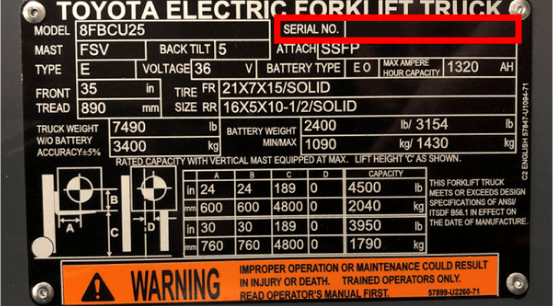How to Find Your Equipment Model Number.
Finding the right parts for your equipment is easy when you have your model and serial number which can be found on the data plate. Luckily, a forklift data plate is installed on every truck on the market to help you understand what your forklift can do and provide vital information.
Model Number: The model number of your toyota forklift is extremely important for relaying information to your dealers about repair or technical assistance and for looking up replacements part!
Serial Number: The serial number on your lift is the most important number.The model serial number combination will allow us to provide you with the parts that will fit your particular piece of equipment.

How to Find Your Equipment Serial Number
Finding the right parts for your equipment is easy when you have your model and serial number which can be found on the data plate. Luckily, a forklift data plate is installed on every truck on the market to help you understand what your forklift can do and provide vital information.
Model Number: The model number of your toyota forklift is extremely important for relaying information to your dealers about repair or technical assistance and for looking up replacements part!
Serial Number: The serial number on your lift is the most important number.The model serial number combination will allow us to provide you with the parts that will fit your particular piece of equipment.

Need some help? For further assistance or more information, contact your local Toyota Dealer.

Please click below to sign in to your MyToyota account
Don't have an account?
Loading Dock Safety

Forklift accidents can happen anywhere, but because loading docks are typically narrow and elevated, they’re one place where extra caution should be used. Common loading dock incidents include falling off the edge of the dock, and skidding or slipping due to wet or icy conditions. So how can the risk of loading dock accidents be reduced?
Secure the Trailer to Maximize Safety
First and foremost, make sure the trailer is secured to the dock using a locking device, either on the trailer’s rear impact guard or rear wheel. One common and dangerous issue that can arise when loading and unloading trailers in a loading dock, is the truck driver not realizing the forklift is still in the truck and pulling away, which causes the forklift to roll out. “Trailer Creep”, which happens when trailers gradually move away from the dock because of constant movement inside them, can also happen. The only way to prevent these two things from happening is to completely secure the trailer with a locking device on the trailer’s rear impact guard or rear wheel.
Clean and Maintain the Loading Dock
Clean off the surface of the loading dock. One common cause of accidents involving forklifts and loading docks is ice or water covering the dock. Clean the dock off before operating the forklift on it to help prevent sliding issues.
Also, remember to always maintain a safe distance from the edge of the loading dock. OSHA doesn’t recommend a specific measurement between a forklift and the edge of a loading dock, but you should implement good judgment to avoid falling off the side of the loading dock. Painting the edges of the loading dock a bright color is one thing you can do to help forklift operators stay aware of dock edges.
Reducing Accidents on Loading Docks
By doing the three things above, you’re well on your way to reducing accidents on loading docks, but keep these things in mind too:
- Anyone operating a forklift should be trained. Proper operating training is the number-one way to prevent accidents.
- Implementing a daily loading dock inspection is important to the safety of operators and truck drivers alike.
- Keep the product secure on your pallets by covering them in plastic or metal.
- Double-check the floors of trailers before driving on them to ensure they’re sturdy enough to handle the weight of the forklift.
- Consider creating a dock shelter to keep rain and snow off loading docks, which can cause them to be slippery.